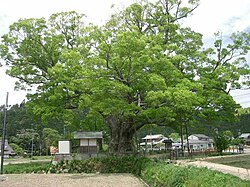Biota of Tokyo Imperial Palace
An untouched, vast open space in the middle of Tokyo hosts diverse species of wildlife which have been catalogued in field research.
That started with moving the primary residences of the Gosanke, who were three major relatives of Tokugawa shogunate; outside of the Edo Castle and dedicating the vacated space to fire prevention.
During the rule of Tokugawa Yoshimune (1716–1745), the Fukiage gardens changed considerably in accord with his philosophy of the promotion of diligence, industrial development and the encouragement of literary and martial arts.
These reports are not available to the public, but provide precise information about the vegetation, its time-course changes, old historic and giant trees.
[11] When Tokugawa Ieyasu entered the Edo castle in 1590, there was a beautiful coastline fringed with Japanese black pine trees.
Investigations between 1996 and 1999 revealed woods with broad-leaved evergreen forest trees such as Ilex integra, Castanopsis sieboldii, and Machilus thunbergii on the periphery of the Fukiage Garden, namely over the Dokan Moat, and woods with deciduous broad-leaved trees such as Quercus acutissima in the central part of the Garden.
Well-grown trees and elements of Satoyama such as fruit gardens provide good circumstances for small animals such as insects.
In the Yamabukino Nagare of the Fukiage Gardern, Tokugawa Ienari (office 1787 - 1837) ordered the transplantation of famous 40 black pine trees, which were 17 in the Taisho era and 5 in 1986, including those which were re-transplanted.
He took Hirohito for a walk in the woods on the island, then gave him a 25-minute lecture, on board the royal ship Nagato, on slime molds on June 1, 1929.
Minakata presented the Emperor with gifts including 110 specimens of slime molds kept in empty taffy boxes.
[16] The second is Liquidambar formosana Hance (English name: sweet gum) (Japanese name: fū), which was transplanted from China in 1727 by Tokugawa Yoshimune.
Evergreen, broad-leafed species such as Cinnamomum camphora, Machilus thunbergii, and Lithocarpus edulis were differentiated from temperate deciduous trees, such as cherry blossoms, Quercus acutissima, Zelkova serrata and Acer palmatum.
According to Tanaka, Hirohito's idea of leaving old-Tokyo woods in the Palace was based on his experience of the 1923 Great Kantō earthquake; it should be a place for evacuation.
[20] Small Japanese mole (Mogera imaizumii) is considered to have lived from the Edo era, while the origin of raccoon dog and masked palm civet which were found in the Palace remains unknown.
But the latter two animals are found inside Tokyo Prefecture such as Imperial Akasaka residences and in Machida city,[21] and probably they are not of pet origin.
Around 1975, the common kingfisher, the Japanese pygmy woodpecker, the Hakusekirei (Motacilla alba lugens) which is a kind of white wagtail, and the brown-eared bulbul have become sedentary birds on the Palace grounds.
The route of common kingfisher to the Palace is being investigated, and was thought to be through green open spaces in neighboring Tokyo areas.
Little grebe, great cormorant, black-crowned night heron, little egret, grey heron, Mandarin duck, mallard, Eastern spot-billed duck, Eurasian wigeon, northern pintail, tufted duck, black kite, northern goshawk, Eurasian sparrowhawk, nosuri (Japanese) Buteo japonicus, common moorhen, black-headed gull, European herring gull, Oriental turtle dove, lesser cuckoo, brown boobook, common kingfisher, Japanese green woodpecker, Japanese pygmy woodpecker, barn swallow, common house martin, grey wagtail, Motacilla alba lugens, brown-eared bulbul, bull-headed shrike, Daurian redstart, pale thrush, Naumann's thrush, Japanese bush warbler, goldcrest, coal tit, varied tit, Japanese tit, warbling white-eye, meadow bunting, black-faced bunting, hawfinch, Eurasian tree sparrow, white-cheeked starling, azure-winged magpie, carrion crow and jungle crow.
Freshwater shellfishes previously commonly seen in Japan became rare, but they were seen in the Palace, including Sphaerium japonicum, a kind Viviparidae and Radix auricularia.
Some of those which disappeared in central Tokyo were found, such as biniitotonbo (Ceriagrion nipponicum), kosanae and aoyanma (Aeschnophlebia longistigma).
Some of them might have been introduced with the plants transplanted into the Palace, since earlier investigations in the ku areas of Tokyo Prefecture revealed less than 200 species.
According to the survey between 1996 and 1998, three families and 738 species of Beetles were confirmed in the Palace including Prosopocoilus inclinatus, which is rarely seen in central Tokyo.
Forty-nine species of ants were confirmed in the Palace; which is a larger number than that in Ota-ku, Nakano-ku, and Itabashi-ku, Tokyo.
The reason why western honey bees are smaller in number might be that Apis cerane japonica has resistance to larger Vespinae.
The ecology studies with Drosophilidae in the Palace and the experimental plantation in Chiba revealed that both places have woods, and grassland and marshland in common, serving to the diversity of animals.
Based on the distribution of Myriapoda and spiders, the Tokyo Imperial Palace area had been a laurel forest facing the sea, before the entry of Tokugawa Ieyasu into the Edo castle.
Although it is not a virgin forest, the Tokyo Imperial Palace is exceptionally rich in nature, considering its location in the heart of a great city.
While small Japanese mole has outlived a long history since the Edo era, this is an exceptional case, and it is considered that many living creatures and plants have disappeared.
As constituents of animals and vegetation, Cryptoparlatorea edentata (Takagi et Kawai, 1966) might have been introduced in the Edo era with transplanted fir, indicating the effects of trees at large.
Some of the living creatures without an ability to move may disappear, while the introduction of bullfrogs produced immense effects on other animals.





















